


SEARCH MyCVEC
Prepare for an Outage
Outage FAQs:
Things to keep in mind
![]() CVEC crews will work as long as allowable each day and will restore service in an orderly manner, utilizing safe and effective work practices.
CVEC crews will work as long as allowable each day and will restore service in an orderly manner, utilizing safe and effective work practices.
![]() CVEC will use contractors and visiting linemen who may travel from sister cooperatives once they know that their home system is not in jeopardy.
CVEC will use contractors and visiting linemen who may travel from sister cooperatives once they know that their home system is not in jeopardy.
![]() During large outages, field personnel have specialized assignments. Some are clearing trees, others are patrolling lines or guiding visiting linemen, others are working on major circuits, while some crews may be focusing on single-phase lines. Division superintendents and our dispatch center are coordinating the field personnel. Therefore, the crews in the field may not be able to provide specific or comprehensive information to members.
During large outages, field personnel have specialized assignments. Some are clearing trees, others are patrolling lines or guiding visiting linemen, others are working on major circuits, while some crews may be focusing on single-phase lines. Division superintendents and our dispatch center are coordinating the field personnel. Therefore, the crews in the field may not be able to provide specific or comprehensive information to members.
Adj![]() oining homes may be fed from different power lines. Some members express concern when they notice that their neighbor’s power has been restored, and then the repair truck departs. There is probably a known fault along the line that feeds the other homes in the neighborhood.
oining homes may be fed from different power lines. Some members express concern when they notice that their neighbor’s power has been restored, and then the repair truck departs. There is probably a known fault along the line that feeds the other homes in the neighborhood.
![]() Some members have alerted CVEC regarding their medical conditions. These members will be given preference when possible. As a practical matter, expediting power restoration is often not possible when multiple fault locations exist between the substation and the member’s home. CVEC advises members with medical conditions to have a plan to relocate to an area with power in the event of an extended power outage.
Some members have alerted CVEC regarding their medical conditions. These members will be given preference when possible. As a practical matter, expediting power restoration is often not possible when multiple fault locations exist between the substation and the member’s home. CVEC advises members with medical conditions to have a plan to relocate to an area with power in the event of an extended power outage.
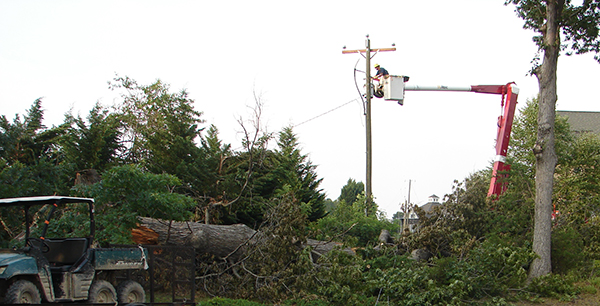
![]()
When will power be restored?
![]() Since there is little in the way of a feedback mechanism during repair efforts, dispatchers will know little until crews arrive in the field and complete repair work at the initial fault location.
Since there is little in the way of a feedback mechanism during repair efforts, dispatchers will know little until crews arrive in the field and complete repair work at the initial fault location.
![]() As a result, isolated outages are typically resolved before reliable information is available to accurately predict a restoration time. In general, expect a 2-4 hour time frame if all goes well in repairing a single site fault.
As a result, isolated outages are typically resolved before reliable information is available to accurately predict a restoration time. In general, expect a 2-4 hour time frame if all goes well in repairing a single site fault.
![]() Once the line is re-energized, some members may have power restored, while others may remain without power if another fault location exists further down line.
Once the line is re-energized, some members may have power restored, while others may remain without power if another fault location exists further down line.
![]() During extended and widespread outages, educated estimations of restoration time can be made for substation areas and for complete restoration.
During extended and widespread outages, educated estimations of restoration time can be made for substation areas and for complete restoration.
![]() During widespread and extended outages, it is not uncommon to see half of the initial outages resolved within 24 hours. As restoration work proceeds out to the single-phase lines, progress appears to slow down since repair work at each fault location benefits fewer and fewer members. CVEC often has outages resolved within 5-7 days after a major weather event, but the final two days are often required to restore service to the last 10% of affected members.
During widespread and extended outages, it is not uncommon to see half of the initial outages resolved within 24 hours. As restoration work proceeds out to the single-phase lines, progress appears to slow down since repair work at each fault location benefits fewer and fewer members. CVEC often has outages resolved within 5-7 days after a major weather event, but the final two days are often required to restore service to the last 10% of affected members.
![]() CVEC is actively gathering e-mail addresses, home telephone numbers and cell phone numbers in anticipation of the ability to remain in contact with members during power outages.
CVEC is actively gathering e-mail addresses, home telephone numbers and cell phone numbers in anticipation of the ability to remain in contact with members during power outages.
![]() As a member-owned Cooperative, CVEC always protects the privacy and security of your information.
As a member-owned Cooperative, CVEC always protects the privacy and security of your information.
You can read more info about power restoration here.
![]()
Why does my clock blink?
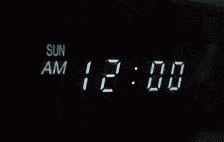 Each spring, we receive calls from concerned members saying that every time a thundershower occurs, their LED clock lights blink on and off, and they have to reset all them.
Each spring, we receive calls from concerned members saying that every time a thundershower occurs, their LED clock lights blink on and off, and they have to reset all them.
"April showers bring May flowers..." is a line from a poem that most of us learned in grade school. It brings back memories of pleasant spring mornings with occasional afternoon showers. But for all the freshness and beauty of spring, we must also contend with one of nature's most dramatic events - the fury of a thunderstorm.
The severe lightning that accompanies a springtime thunderstorm can sometimes wreak havoc on an electrical distribution system. With voltages exceeding several million volts and temperatures approaching 27,000 degrees Fahrenheit, lightning can destroy anything that lies in the electrical path that is forged between ground and sky.
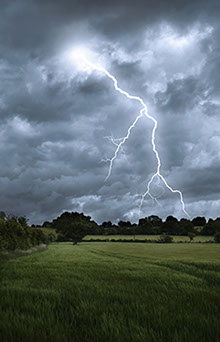 Even though electrical facilities are insulated to withstand high magnitudes of voltage, they are sometimes no match for the awesome power unleashed by a lightning strike. The extreme heat generated by these high-level charges can explode trees by vaporizing their sap and can melt sand into shards of glass.
Even though electrical facilities are insulated to withstand high magnitudes of voltage, they are sometimes no match for the awesome power unleashed by a lightning strike. The extreme heat generated by these high-level charges can explode trees by vaporizing their sap and can melt sand into shards of glass.
The answer to the problem of "tattletale" clocks is simple: buy one with a battery backup. These clocks do not require resetting when the lights blink, and also maintain accurate time during an extended outage.
The solution to the blinking lights is a little more complicated, and by the same token, much more interesting. Let's take a look.
CVEC installs various protective devices on its electrical system to take care of temporary or "transient" system disturbances. One of these devices is a lightning arrester. Every transformer is equipped with one. Also, they are placed at certain locations along the line and at every place where the line dead-ends. Lightning arresters are connected between the high-voltage conductor and the ground wire. By their physical makeup, they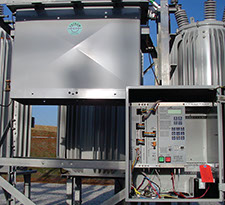 act as a high-voltage resistor, not allowing voltage or current to pass through during their at-rest or static state.
act as a high-voltage resistor, not allowing voltage or current to pass through during their at-rest or static state.
However, when lightning arresters sense a higher-than-normal voltage on the line, caused by lightning for example, they turn on and allow the voltage to flow through them to ground. Therefore, they work as a shunt, allowing the high voltage to go around the piece of equipment being protected. Usually, the arrester will turn itself off after the high voltage has passed through and returns to its normal characteristic of a resistor. Sometimes, however, the stresses generated by a lightning strike will be so great that the arrester will literally explode.
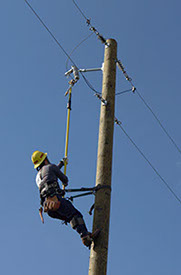 In either case, our second means of protection comes into play. During times of system disturbance when high magnitudes of voltage and current are present, line reclosers are used to de-energize the distribution circuit. If lightning causes the disturbance, then the recloser opens up long enough to allow the arrester to get the lightning off of the line. It immediately "recloses" to restore power. At this point, you notice the lights blinking. If a permanent fault, such as a tree on the line, causes the disturbance, then the recloser will turn itself on and off several times, trying to rid itself of the problem. If the fault remains after multiple blinks, then the recloser will turn itself off until the fault is removed. This step requires that a CVEC crew correct the problem, then re-energize the line.
In either case, our second means of protection comes into play. During times of system disturbance when high magnitudes of voltage and current are present, line reclosers are used to de-energize the distribution circuit. If lightning causes the disturbance, then the recloser opens up long enough to allow the arrester to get the lightning off of the line. It immediately "recloses" to restore power. At this point, you notice the lights blinking. If a permanent fault, such as a tree on the line, causes the disturbance, then the recloser will turn itself on and off several times, trying to rid itself of the problem. If the fault remains after multiple blinks, then the recloser will turn itself off until the fault is removed. This step requires that a CVEC crew correct the problem, then re-energize the line.
Other types of protective devices safeguard our electric lines. However, lightning arresters and line reclosers do most of the work during an electrical storm.
We know that blinking lights can sometimes become a nuisance. But rest assured that our equipment is working hard to maintain continuous and reliable electrical service. Without the use of such protective devices, blinking lights could become extended outages.
HOME | REPORT AN OUTAGE | PAY MY BILL | CONTACT CVEC
Phone: 434.263.8336 | Toll free: 800.367.2832 | Fax: 434.263.8339
Corporate Headquarters:
800 Cooperative Way
Arrington, VA 22922
Payments:
Dept. 1340 | PO Box 2153
Birmingham, AL 35287-1340
Correspondence:
P. O. Box 247
Lovingston, VA 22949
